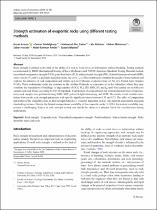| dc.description.abstract | Rock strength is defined as the limit of the ability of a rock to resist stress or deformation without breaking. Testing methods
recommended by ISRM (International Society of Rock Mechanics) and ASTM (American Standards Testing Material) include
unconfined compressive strength (UCS), point load index (PLI), indirect tensile strength (ITS), Schmidt hammer rebound (SHR),
sonic velocity (Vp and Vs), and slake durability index 2nd cycle (Id2). This contribution compares the results of these methods and
explores the influence of rock composition and texture on Lower Miocene evaporites from Al Ain city, United Arab Emirates
(UAE). These sedimentary rocks are common in the Arabian Peninsula as exposures or in the subsurface where they may
constitute the foundations of buildings. A large number of UCS, PLI, ITS, SHR, SV, and Id2 tests were carried out on both core
samples and rock blocks according to ASTM Standards. Examination of compositional and textural characteristics of representative
rock samples was performed using XRD, XRF, polarized-light microscopy, and SEM. The results reveal variable correlations
between the rock strength parameters with specific significant values between 0.53 and 0.72. The effect of composition
and texture of the evaporitic rocks on their strength behavior is related to impurities such as clay minerals and celestite and grain
interlocking textures. Despite the limited compositional variability of the evaporitic rocks (5–10%), the textural variability may
present a challenging feature in rock strength testing and should be taken as a primary factor for consideration during
applications. | en_US |

